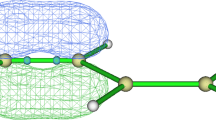Abstract
Metal clusters often show slight deviations from high molecular point group symmetry. The reason for this is a Jahn–Teller distortion because of partial occupation of orbitals that are degenerate in the highly symmetric case. For heavy elements spin–orbit coupling, which usually is not regarded in quantum chemical treatments of clusters, becomes non-negligible. This leads to splitting of degenerate orbitals, so that the reason for distortion is no longer given. In a rigorous study of neutral, cationic and anionic 4–6 atomic clusters of W, Re, Tl and Pb it is demonstrated that in some cases regarding spin–orbit coupling indeed yields a highly symmetric global minimum structure, whereas neglecting this effect leads to distorted structures of lower symmetry.



Similar content being viewed by others
References
R. Ahlrichs and S. Elliott (1999). Phys. Chem. Chem. Phys. 2, 313.
F. Furche, R. Ahlrichs, P. Weis, C. Jacob, S. Gilb, T. Bierweiler, and M. M. Kappes (2002). J. Chem. Phys. 117, 6982.
F. Weigend and A. Baldes (2010). J. Chem. Phys. 133, 174102.
U. Wedig, V. Saltykov, J. Nuss, and M. Jansen (2010). J. Am. Chem. Soc. 132, 12458.
V. Saltykov, J. Nuss, U. Wedig, and M. Jansen (2011). Z. Allg. Anorg. Chem. 637, 357.
M. Sierka, J. Döbler, J. Sauer, G. Santambrogio, M. Brümmer, L. Wöste, E. Janssens, G. Meijer, and K. R. Asmis (2007). Angew. Chem. Int. Ed. 46, 3372.
A. D. Becke (1988). Phys. Rev. A 38, 3098.
J. P. Perdew (1986). Phys. Rev. B 33, 8822.
B. Metz, H. Stoll, and M. Dolg (2000). J. Chem. Phys. 113, 2563.
D. Figgen, K. A. Peterson, M. Dolg, and H. Stoll (2009). J. Chem. Phys. 130, 164108.
F. Weigend (2006). Phys. Chem. Chem. Phys. 8, 1057.
TURBOMOLE V6.3, TURBOMOLE GmbH Karlsruhe, 2011, http://www.turbomole.de. TURBOMOLE is a development of University of Karlsruhe and Forschungszentrum Karlsruhe 1989–2007, TURBOMOLE GmbH since 2007.
M. K. Armbruster, F. Weigend, C. van Wüllen, and W. Klopper (2008). Phys. Chem. Chem. Phys. 10, 1748–1756.
A. Baldes and F. Weigend (in preparation) (the feature is available in TURBOMOLE V6.3).
P. Nava, M. Sierka, and R. Ahlrichs (2003). Phys. Chem. Chem. Phys. 5, 3372.
Author information
Authors and Affiliations
Corresponding author
Rights and permissions
About this article
Cite this article
Baldes, A., Gulde, R. & Weigend, F. Jahn–Teller Distortion Versus Spin–Orbit Splitting: Symmetry of Small Heavy-Metal Atom Clusters. J Clust Sci 22, 355–363 (2011). https://doi.org/10.1007/s10876-011-0379-1
Received:
Published:
Issue Date:
DOI: https://doi.org/10.1007/s10876-011-0379-1




